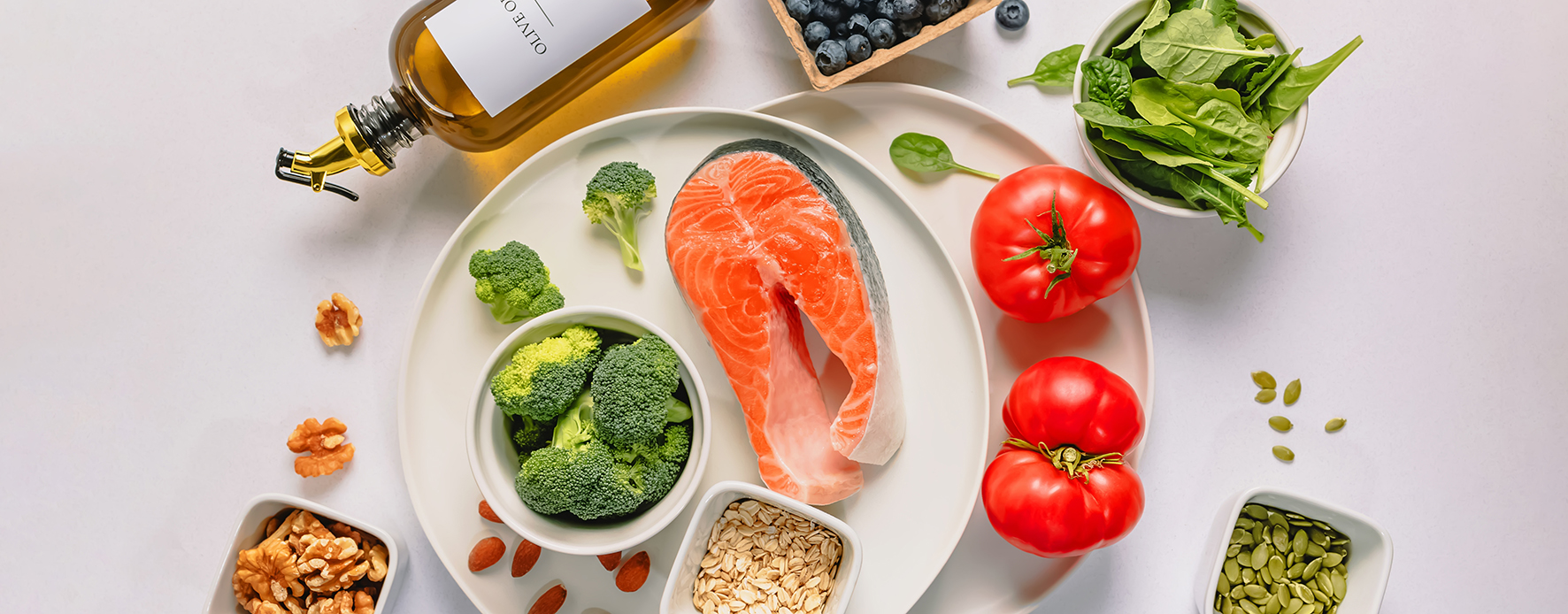Do you know how much carbon is hidden in your food cupboard? While low-energy cooking methods have been enjoying the spotlight – with thanks to the trusty air fryer – eco-friendly foodies can take their energy efficiency and green gastronomy goals a step further by examining the carbon footprint of the foods they eat.
From cutting emissions to slicing food waste, B-corp certified meal delivery service Gousto is all about putting Mother Earth first. So Gousto chef Sophie Nahmad is taking a closer look at the secret ingredients which are low on carbon and big on feel-good flavour for the perfect planet-friendly plateful, and Head of Sustainability Hugh Lewis explains how so much carbon can become embedded in what we eat.
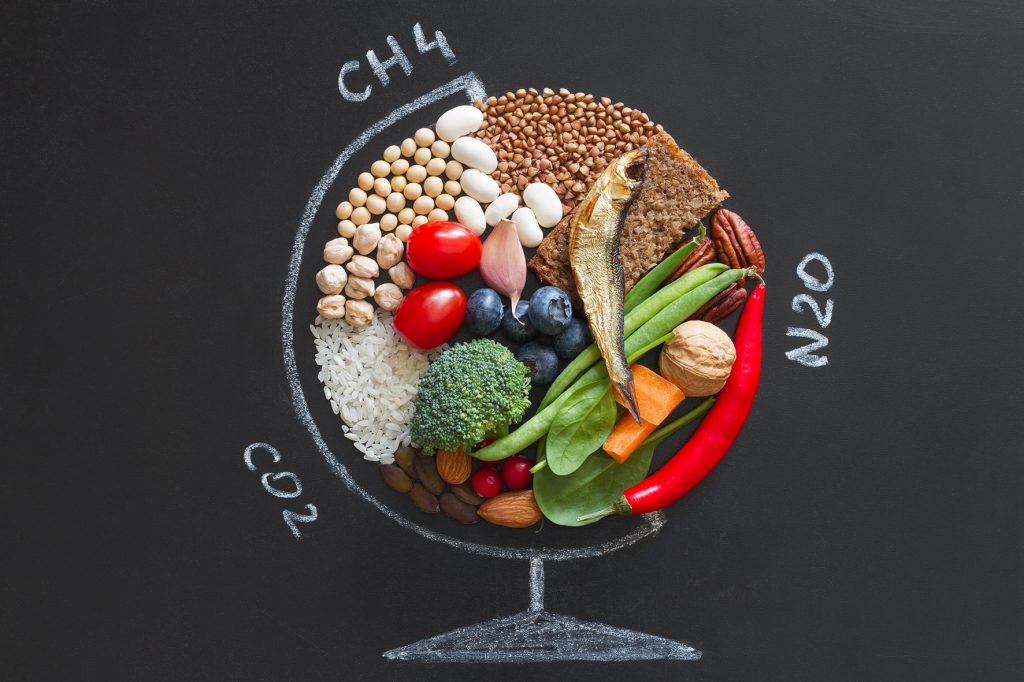
So… How can you reduce the carbon footprint of your diet?
Reduce your meat and dairy consumption
Sophie says: “Cutting down on meat and dairy consumption is a sure-fire way to make your diet more sustainable, but that doesn’t mean having vegan meals is the only sustainable way to eat. If you cook beef three to five days in a week, trimming that back to one or two times a week would reduce your carbon footprint by over 1000kgs of CO2 emissions*; that’s as much as the energy you’d use to heat your home for 130 days!
Make eco-friendly swaps
“If you want to make a bigger impact, swapping your beef intake altogether for white meats like chicken can reduce your associated carbon footprint by more than eight times* without needing to go completely meat-free. Alternatively, tofu is a vegan protein source that has a significantly lower carbon footprint than meat.
Shop locally for what’s in season
“Equally, have a think about where your food comes from. Many foodstuffs now tell you where their produce came from, so you can get a sense of the food miles that come with it.
“If you have strawberries grown in England and America, choosing the English strawberries can lower your food miles – but if you’re buying English strawberries in Winter, they’re more likely to have been grown in a heated greenhouse, creating emissions which can counteract the reduced carbon created in transport.
“It’s a balancing act, but buying local produce when it’s in season, and thinking more intentionally about when and where your food is grown can help you manage your carbon footprint.
Think about how you transport your food
“The only part of how much energy is in the food chain that you’re in full control of, is how you get your food to your home. If you’re driving in a car to do your weekly food shop rather than walking, cycling, or using public transport, your own fuel emissions are inflating the carbon cost of your food.
“A food subscription can cut out the fuel-guzzling trips to and from a supermarket. If everyone in the UK got one recipe box delivered to their door every week instead of driving to the supermarket, it could save 10.3 million tonnes of CO2 each year!”
Get a recipe box!
“Why not cut out the stress as well as the carbon from your food shop and let someone else take care of it all? At Gousto we produce 23% less carbon emissions than supermarkets. We achieve this through a number of means, from cutting food waste to having a more efficient and shorter supply chain.
“Because we deliver to door, we have fewer vans producing emissions on the road, and we’re committing to sourcing all our fresh meat from Britain to cut down on air miles. Our commitments to reducing our impact on the environment means we can do heavy lifting for you, so you can enjoy all the benefits of an eco-friendly diet.”
The ultimate low carbon shopping list:
- Protein: tofu and eggs, beans
- Carbs: pasta, oats, bread, potatoes
- Fruit and vegetables: apples, citrus fruit, peas (but seasonal and locally grown is best!)
What is the carbon footprint of food?
“A carbon footprint counts the greenhouse gas emissions of every process involved in creating and disposing of something across its whole life,” says Hugh Lewis, Head of Sustainability at Gousto. “For food, the carbon footprint includes any emissions created across land use, farming, animal feed, processing, transport and sale, and even what packaging it comes in.
“Because every ingredient has different needs across these points in their life, carbon footprint can vary hugely from one foodstuff to the next. Green gastronomers who understand these differences can get creative with their ingredients, and create the ultimate lower carbon feast.
What impacts the carbon footprint of food?
“There are many aspects of food growing and rearing that we everyday home cooks can’t control, but if we know where the hotspots are for certain foods, we can adjust our food choices to reduce their impact.
“Animal products for example need much more land and farming infrastructure than crops. Because of this, research from Our World in Data in 2020 found that carbon emissions from most plant-based products were as much as 10 to 50 times lower than most animal-based products! Red meat especially, like beef and lamb, create half of all emissions coming from farmed animals.
“Transportation is also a big factor in energy consumption. Most of the beef we eat in the UK comes from overseas, so it has to be transported by air or sea to get to your local supermarket. These ‘food miles’ can pile up and make the carbon footprint of foods sourced from abroad even higher.”
3 sustainable recipes to help you master Green Gastronomy
Fancy turning your hand to the world of green gastronomy? Here are some of Sophie’s favourite recipes to put those sustainably scrumptious low carbon ingredients to work.
Plant Based Crispy Teriyaki Tofu with Sticky Rice
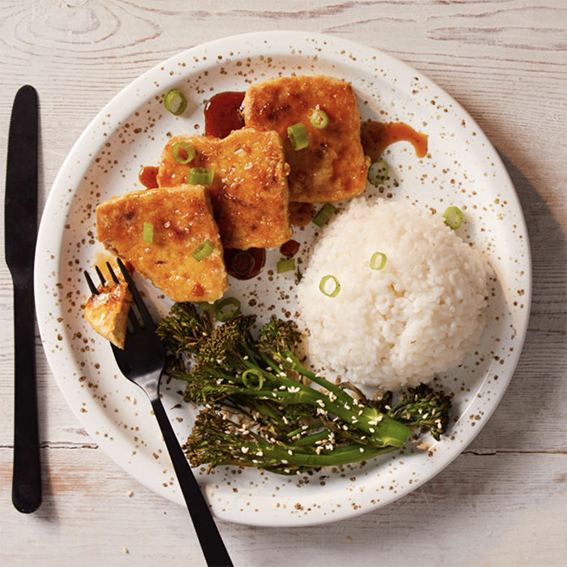
Instructions for 2 portions
Time: 35 minutes
Ingredients:
- 25g agave nectar
- 160g Tenderstem broccoli
- 4 tbsp cornflour
- 15g fresh root ginger
- 10ml toasted sesame oil
- 150g sushi rice
- 5g toasted sesame seeds
- 30ml Chinese rice wine
- 30ml soy sauce
- 280g plain tofu
- 30ml mirin
- 1 spring onion
- 1 garlic clove
You’ll also need: salt, sugar, vegetable oil, water
Method:
1.
Preheat the oven to 200°C/ 180°C (fan)/ gas 6. Rinse your sushi rice in a sieve under cold running water for 30 secs (use your hands to really wash the grains!), then set aside to drain fully. Add the drained rice with 200ml cold water and a generous pinch of salt to a pot with a lid and bring to the boil over a high heat.
2.
Once boiling, reduce the heat to low until very gently bubbling and cook, covered, for 15 min. After 15 min, remove the pot from the heat and keep covered for a further 10 min before serving – this is your sticky rice.
Tip: Don’t peek! Keep the lid on the whole time to get fluffy and sticky rice!
3.
Peel (scrape the skin off with a teaspoon) and finely chop (or grate) your ginger, then peel and finely chop (or grate) your garlic. Heat a large, wide-based pan (preferably non-stick) with a drizzle of vegetable oil over a medium heat. Once hot, add the chopped garlic and ginger and cook for 2-3 min or until fragrant.
4.
Once fragrant, add your soy sauce, mirin, Chinese rice wine, agave, and 1 tbsp sugar. Increase the heat to high and cook for 1-2 min further, stirring constantly, or until thickened. Once thickened, pour into a bowl and keep to one side – this is your teriyaki sauce (wipe the pan clean and save it for later!)
Tip: The sauce will thicken more as it cools!
5.
Add your Tenderstem broccoli to a baking tray and put the tray in the oven for 10-12 min or until crisp and cooked through.
Meanwhile, drain your tofu and cut into 3 slices lengthways per person, then pat each one thoroughly dry with kitchen paper. Add your cornflour to a plate and press each tofu slice into the cornflour firmly, until evenly coated all over.
6.
Return the reserved pan to a high heat with a generous drizzle of vegetable oil. Once the pan is hot, add the coated tofu and cook for 3-4 min on each side or until browned and crispy. While the tofu is cooking, trim, then slice your spring onion finely.
7.
Once the tofu is crispy, reduce the heat to low and add 1 tbsp teriyaki sauce (you’ll use the rest later!), stirring to coat each tofu slice – this is your crispy teriyaki tofu. Once the broccoli is cooked, add your toasted sesame oil and toasted sesame seeds to the tray and give everything a good mix up – this is your sesame broccoli. Serve the crispy teriyaki tofu with the sticky rice and sesame broccoli to the side.
Tip: For fancy presentation, press the rice into a small bowl and turn out.
Spoon the remaining teriyaki sauce over the tofu and garnish with the sliced spring onion.
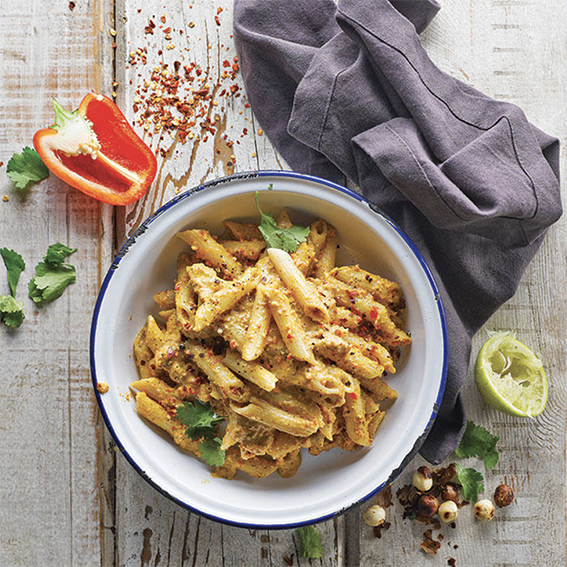
Instructions for 2 portions
Time: 30 minutes
Ingredients:
- 1 Bag of hazelnuts
- 20g fresh coriander
- 2 garlic cloves
- 1 lime
- 2 red peppers
- 30g rennet-free parmesan
- 1tsp chilli flakes
- 200g penne pasta
You’ll also need: pepper, salt, olive oil
Method:
1.
Boil a kettle (used in step 5). Preheat the oven to 200°C/ 180°C (fan)/ 400°F/ Gas 6.
2.
Chop the coriander roughly. Deseed the red peppers and cut into squares. Crush the garlic with the side of a knife, peel it and chop roughly.
3.
Place the red peppers on an oven-proof tray. Sprinkle with the garlic, 2-3 tbsp of olive oil and salt to your taste. Mix well to ensure that the peppers are well coated. Place in the oven for 15 min or until the peppers are soft.
4.
Meanwhile, grate the parmesan.
5.
Cook the pasta in a pot of boiling water and salt (optional) for 8 min or until the pasta is cooked to your taste, stirring occasionally, then drain.
6.
Put a pan on medium-high heat and dry roast (no oil needed) the hazelnuts for approx. 5 min or until well browned. Keep stirring and adjust the heat if necessary to prevent burning.
7.Put the coriander, red peppers, garlic, hazelnuts, 1/2 of the red chilli flakes, the juice of 1/2 the lime and 2 tbsp of olive oil in a blender or pestle and mortar. Blend to a rough paste, add the grated parmesan and season to your taste. Add more chilli flakes if desired, tasting after each addition. Combine the pesto and the pasta in the pan. Season with lime juice to your taste and serve.
Asparagus & Pea Pie with Roasties
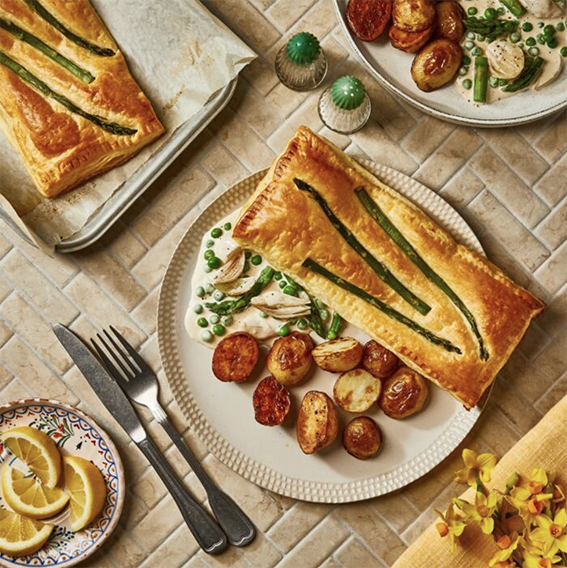
Instructions for 2 portions
Time: 45 minutes
Ingredients:
- 250ml creamy single oat
- 11g vegetable stock mix
- 160g puff pastry
- 160g blanched peas
- 120g asparagus
- 300g waxy potatoes
- 3 shallots
- 2 garlic cloves
- 1 lemon
You’ll also need: olive oil, pepper, salt, vegetable oil, flour
Method:
1.
Preheat the oven to 200°C/ 180°C (fan)/ gas 6. Boil half a kettle. Chop the waxy potatoes in half, lengthways. Add the chopped potatoes to a baking tray with a drizzle of vegetable oil and a generous pinch of salt and pepper and give everything a good mix up. Put the tray in the oven for 25-30 minutes or until golden.
2.
Peel and quarter the shallots. Heat a large, wide-based pan (preferably non-stick) with a drizzle of olive oil over a medium-high heat. Once hot, add the quartered shallots to the pan with a pinch of salt and cook for 3-4 min or until they are slightly softened and beginning to caramelise.
3.
While the shallots are caramelising, peel and finely chop (or grate) the garlic. Slice 3 asparagus lengthways, then chop the remaining asparagus into bite-sized pieces.
4.
Once the shallots have caramelised, add the chopped garlic to the pan with a pinch of salt and cook for 1 min further or until the garlic has softened. Once softened, add the creamy single oat to the pan with the vegetable stock mix and 50ml boiled water. Season with a generous grind of black pepper and bring to the boil over a high heat, once boiling, reduce the heat to low and cook for 6-7 min or until reduced to a thicker consistency.
5.
Dust your work surface with a generous sprinkling of flour. Unwrap the puff pastry and roll it out to approx. 1 cm thickness with a rolling pin and cut into 2 rectangles. Press the halved asparagus into the pastry diagonally and crimp the borders with a fork.
6.
Add the pastry rectangles to a non-stick baking paper-lined baking tray. Put the tray in the oven for 15 min or until the pastry is puffed up, golden and cooked through – these are your asparagus pie lids.
7.
When the pastry has 10 min left, roll the lemon with your hand on a hard surface (to release more juice) and cut in half. Add the chopped asparagus and blanched peas to the pan with the juice of 1/2 lemon and a very generous crack of black pepper. Cook for 8-9 min or until the asparagus is tender with a slight bite – this is your asparagus & pea pie filling.
Cut the remaining lemon into wedges and serve the asparagus & pea pie filling with the roasties to the side. Top the pie filling with the asparagus pie lids and garnish with the lemon wedges.
*Calculated using BBC’s Food Carbon Calculator

